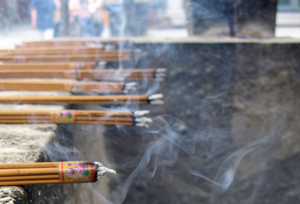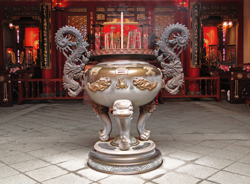/
Please note that the prices on www.beechinheong.com are guide prices only and are only approximate. Our friendly Customer Support will contact you once your order has been made to finalize the delivery and also the final bill.
Incense Culture

Incense is aromatic biotic material which releases fragrant smoke when burned. The term refers to the material itself, rather than to the aroma that it produces. Incense is used for a variety of purposes, including the ceremonies of all the main religions, to overcome bad smells, repel insects, spirituality, aromatherapy, meditation, and for simple pleasure.
Incense is composed of aromatic plant materials, often combined with essential oils. The forms taken by incense differ with the underlying culture, and have changed with advances in technology and increasing diversity in the reasons for burning it. Incense can generally be separated into two main types: "indirect-burning" and "direct-burning". Indirect-burning incense (or "non-combustible incense") is not capable of burning on its own, and requires a separate heat source. Direct-burning incense (or "combustible incense") is lit directly by a flame and then fanned or blown out, leaving a glowing ember that smoulders and releases fragrance. Direct-burning incense is either a paste formed around a bamboo stick, or a paste that is extruded into a stick or cone shape.
Incense is composed of aromatic plant materials, often combined with essential oils. The forms taken by incense differ with the underlying culture, and have changed with advances in technology and increasing diversity in the reasons for burning it. Incense can generally be separated into two main types: "indirect-burning" and "direct-burning". Indirect-burning incense (or "non-combustible incense") is not capable of burning on its own, and requires a separate heat source. Direct-burning incense (or "combustible incense") is lit directly by a flame and then fanned or blown out, leaving a glowing ember that smoulders and releases fragrance. Direct-burning incense is either a paste formed around a bamboo stick, or a paste that is extruded into a stick or cone shape.
For over two thousand years, the Chinese have used incense in religious ceremonies, ancestor veneration, Traditional Chinese medicine, and daily life. Agarwood (chénxiāng) and sandalwood (tánxiāng) are the two most important ingredients in Chinese incense.
Along with the introduction of Buddhism in China came calibrated incense sticks and incense clocks. The poet Yu Jianwu (487-551) first recorded them: "By burning incense we know the o'clock of the night, With graduated candles we confirm the tally of the watches." The use of these incense timekeeping devices spread from Buddhist monasteries into Chinese secular society.

It is incorrect to assume that the Chinese only burn incense in the home before the family shrine. In Taoist traditions, incense is inextricably associated with the 'yin' energies of the dead, temples, shrines, and ghosts. Therefore, Taoist Chinese believe burning undedicated incense in the home attracts the dreaded hungry ghosts, who consume the smoke and ruin the fortunes of the family.
However, since Neolithic times, the Chinese have evolved using incense not only for religious ceremonies, but also for personal and environmental aromatherapy. Although misrepresented until recent studies, Chinese incense art is now regarded as one of the esteemed Chinese art forms - next to calligraphy, tea, flower arrangements, antiquities, etc.
